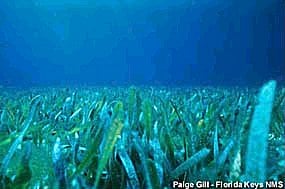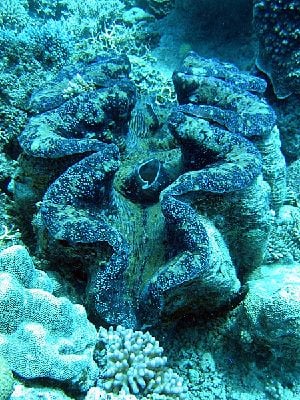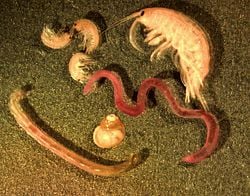Difference between revisions of "Benthic zone" - New World Encyclopedia
Rick Swarts (talk | contribs) |
Rick Swarts (talk | contribs) |
||
| Line 2: | Line 2: | ||
For comparison, the [[pelagic zone]] is the descriptive term for the ecological region above the benthos, including the water-column up to the surface. Depending on the water-body, the benthic zone may include areas which are only a few inches below water, such as a stream or shallow pond; at the other end of the spectrum, benthos of the deep ocean includes the bottom levels of the oceanic [[abyssal zone]]. | For comparison, the [[pelagic zone]] is the descriptive term for the ecological region above the benthos, including the water-column up to the surface. Depending on the water-body, the benthic zone may include areas which are only a few inches below water, such as a stream or shallow pond; at the other end of the spectrum, benthos of the deep ocean includes the bottom levels of the oceanic [[abyssal zone]]. | ||
| + | |||
| + | [[Image:Wfm pelagic.png|thumb|right|Layers of the pelagic zone]] | ||
| + | The '''abyssal zone''' is the [[pelagic zone]] that contains the very deep [[benthic]] communities near the bottom of [[ocean]]s. Abyss is from the [[Greek language|Greek]] word meaning bottomless sea. At depths of 4,000 to 6,000 meters (13,123 to 19,685 feet), this zone remains in perpetual darkness and never receives daylight. Its permanent inhabitants – for example, the [[Black swallower]], [[tripod fish]], deep-sea [[anglerfish]], and the [[giant squid]] – are able to withstand the immense pressures of the ocean depths, up to 775 [[kilogram-force|kilograms]] per square centimeter (76 [[megapascal]]s or 4.92 [[long ton]]s force per square inch). Many abyssal creatures have underslung jaws to sift through the sand to catch food. The deep trenches or fissures that plunge down thousands of feet below the ocean floor – for example, the midoceanic trenches such as the [[Mariana Trench]] in the [[Pacific]] – are almost unexplored. Only the [[bathyscaph]] [[Bathyscaphe_Trieste|Trieste]] and the [[Remote_control|remote control]] [[Submarine|submarine]] [[Kaiko]] have been able to descend to these depths. These regions are also characterized by continuous cold and lack of nutrients. The abyssal zone has temperatures around 2 to 3 degrees Celsius. | ||
| + | |||
| + | |||
| + | The '''Abyssal Zone''' is the benthic zone that extends between about 3,000 to 6,000 meters depth - including the abyssal plains.The Abyssal zone has temperatures around 0 to 3°C but 13-15°C in the Mediterranean sea. | ||
| + | |||
| + | The area below the Abyssal Zone is the sparsely inhabited [[Hadal Zone]]. The zone above is the [[Bathyal Zone]]. These three zones belong to the deep-sea realm. Above on the continental plateform there are respectively the '''Circalittoral, Infralittoral, Mediolittoral''' and '''Supralittoral''' Zones . The [[photic zone]] is independent from this classification. | ||
== Organisms == | == Organisms == | ||
| Line 23: | Line 31: | ||
*[[epibenthos]] lives on top of the sediment | *[[epibenthos]] lives on top of the sediment | ||
*[[hyperbenthos]] lives just above the sediment | *[[hyperbenthos]] lives just above the sediment | ||
| + | |||
| + | Meiofauna are small [[benthos|benthic]] invertebrates that live in both marine and fresh water environments . The term Meiofauna loosely defines a group of organisms by their size, larger than [[Microfauna]] but smaller than [[Macrofauna]], rather than a taxonomic grouping. In practice that is organisms that can pass through a 1 mm mesh but will be retained by a 45 μm mesh, but the exact dimensions will vary from researcher to researcher. Whether an organism will pass through a 1 mm mesh will also depend upon whether it is alive or dead at the time of sorting. | ||
| + | |||
| + | The term '''meiobenthos''' was first coined in 1942 by [[#References|Mare]], but organisms that would fit into the meiofauna category have been studied since the 18th century. A good comprehensive text on meiofauna is [[#References|''Introduction to the study of meiofauna'']] by Higgins and Thiel (1988). | ||
Benthic organisms play an important role as a food source for [[fish]] and some also for [[human]]s. | Benthic organisms play an important role as a food source for [[fish]] and some also for [[human]]s. | ||
| Line 61: | Line 73: | ||
*[http://www.dassh.ac.uk Data Archive for Seabed Species and Habitats] from the UK Marine Data Archive Centre | *[http://www.dassh.ac.uk Data Archive for Seabed Species and Habitats] from the UK Marine Data Archive Centre | ||
| − | + | NOAA Coastal Services Center | |
| + | http://www.csc.noaa.gov/benthic/start/what.htm Benthic Habitat Mapping | ||
| + | Search Benthic Site: | ||
| + | What is Benthic Habitat? | ||
| + | National Oceanic and Atmospheric Administration | ||
{{fisheries}} | {{fisheries}} | ||
| Line 68: | Line 84: | ||
[[Category:Ecology]] | [[Category:Ecology]] | ||
| − | {{credit|Benthic_zone|204813912}} | + | {{credit|Benthic_zone|204813912|Benthos|205490583|Meiobenthos|192035677|Abyssal_zone|204267521}} |
Revision as of 21:24, 18 April 2008
The benthic zone is the ecological region at the lowest level of a body of water such as an ocean or a lake, including the sediment surface and some sub-surface layers. Organisms living in this zone are called benthos. They generally live in close relationship with the substrate bottom; many such organisms are permanently attached to the bottom. Generally, these include life forms that tolerate cool temperatures and low oxygen levels, but this depends on the depth of the water. For information on animals that live in the deepest areas of the oceans see aphotic zone. The superficial layer of the soil lining the given body of water is an integral part of the benthic zone, as it influences greatly the biological activity which takes place there. Examples of contact soil layers include sand bottoms, rock outcrops, coral, and bay mud.
For comparison, the pelagic zone is the descriptive term for the ecological region above the benthos, including the water-column up to the surface. Depending on the water-body, the benthic zone may include areas which are only a few inches below water, such as a stream or shallow pond; at the other end of the spectrum, benthos of the deep ocean includes the bottom levels of the oceanic abyssal zone.
The abyssal zone is the pelagic zone that contains the very deep benthic communities near the bottom of oceans. Abyss is from the Greek word meaning bottomless sea. At depths of 4,000 to 6,000 meters (13,123 to 19,685 feet), this zone remains in perpetual darkness and never receives daylight. Its permanent inhabitants – for example, the Black swallower, tripod fish, deep-sea anglerfish, and the giant squid – are able to withstand the immense pressures of the ocean depths, up to 775 kilograms per square centimeter (76 megapascals or 4.92 long tons force per square inch). Many abyssal creatures have underslung jaws to sift through the sand to catch food. The deep trenches or fissures that plunge down thousands of feet below the ocean floor – for example, the midoceanic trenches such as the Mariana Trench in the Pacific – are almost unexplored. Only the bathyscaph Trieste and the remote control submarine Kaiko have been able to descend to these depths. These regions are also characterized by continuous cold and lack of nutrients. The abyssal zone has temperatures around 2 to 3 degrees Celsius.
The Abyssal Zone is the benthic zone that extends between about 3,000 to 6,000 meters depth - including the abyssal plains.The Abyssal zone has temperatures around 0 to 3°C but 13-15°C in the Mediterranean sea.
The area below the Abyssal Zone is the sparsely inhabited Hadal Zone. The zone above is the Bathyal Zone. These three zones belong to the deep-sea realm. Above on the continental plateform there are respectively the Circalittoral, Infralittoral, Mediolittoral and Supralittoral Zones . The photic zone is independent from this classification.
Organisms
Benthos are the organisms which live in the benthic zone, and are different from the elsewhere in the water column. Many are adapted to live on the substrate (bottom). In their habitats they can be considered as dominant creatures. Many organisms adapted to deep-water pressure cannot survive in the upper parts of the water column. The pressure difference can be very significant (approximately one atmosphere for each 10 meters of water depth).
Because light does not penetrate very deep ocean-water, the energy source for the benthic ecosystem is often organic matter from higher up in the water column which drifts down to the depths. This dead and decaying matter sustains the benthic food chain; most organisms in the benthic zone are scavengers or detritivores.


Benthos are the organisms which live on, in, or near the seabed, also known as the benthic zone.[1] Although the term derived from the Greek for "depths of the sea",[1] the term is also used in freshwater biology to refer to organisms at the bottoms of freshwater bodies of water, such as lakes, rivers, and streams.[2]
Animals belonging to the benthos are sometimes referred to as zoobenthos, while plants are referred to as phyto-benthos.
Benthos can be categorized according to size:
- macrobenthos, size > 1 mm
- meiobenthos, size < 1 mm and > 32 µm
- microbenthos, size < 32 µm
- epibenthos lives on top of the sediment
- hyperbenthos lives just above the sediment
Meiofauna are small benthic invertebrates that live in both marine and fresh water environments . The term Meiofauna loosely defines a group of organisms by their size, larger than Microfauna but smaller than Macrofauna, rather than a taxonomic grouping. In practice that is organisms that can pass through a 1 mm mesh but will be retained by a 45 μm mesh, but the exact dimensions will vary from researcher to researcher. Whether an organism will pass through a 1 mm mesh will also depend upon whether it is alive or dead at the time of sorting.
The term meiobenthos was first coined in 1942 by Mare, but organisms that would fit into the meiofauna category have been studied since the 18th century. A good comprehensive text on meiofauna is Introduction to the study of meiofauna by Higgins and Thiel (1988).
Benthic organisms play an important role as a food source for fish and some also for humans.
Examples of benthic organisms are sea stars, oysters, clams, sea cucumbers, brittle stars and sea anemones.
ReferencesISBN links support NWE through referral fees
- ↑ 1.0 1.1 Benthos from the Census of Antarctic Marine Life website
- ↑ About the North American Benthological Society, from that organization's website
Habitats
In oceanic environements, benthic habitats can be further subdivided based on depth. From the shallowest to the deepest are: the estuarine zone — less than 200 meters; then the bathyal zone — 200-2000 meters; the abyssal — 2000-6000 meters; and the deepest, the hadal zone — over 6000 meters.
All these zones are in deep, pressured areas of the ocean. Because of the high pressure and seclusion neither tidal changes nor human interference has had much of an effect on these areas, and the habitats have not changed much over the years. Many benthic organisms have retained their historic evolutionary characteristics; some organisms have significantly changed size[citation needed].
Humans are not able to map or observe these organisms and their habitats easily, and most observation has been done through remote controlled submarines.
See also
- Armor (hydrology)
- Deep sea
- Littoral
- Profundal zone
- Limnetic zone
- Lake stratification
- Benthos
- Stream bed
- Water column
- Intertidal zone
- Aphotic zone
- Photic zone
- Neritic zone
- Pelagic zone
References
- Fathom
- Data Archive for Seabed Species and Habitats from the UK Marine Data Archive Centre
NOAA Coastal Services Center http://www.csc.noaa.gov/benthic/start/what.htm Benthic Habitat Mapping Search Benthic Site: What is Benthic Habitat? National Oceanic and Atmospheric Administration
| |||||||||||||||||||||||||||||||||||||||||||||||
Credits
New World Encyclopedia writers and editors rewrote and completed the Wikipedia article in accordance with New World Encyclopedia standards. This article abides by terms of the Creative Commons CC-by-sa 3.0 License (CC-by-sa), which may be used and disseminated with proper attribution. Credit is due under the terms of this license that can reference both the New World Encyclopedia contributors and the selfless volunteer contributors of the Wikimedia Foundation. To cite this article click here for a list of acceptable citing formats.The history of earlier contributions by wikipedians is accessible to researchers here:
The history of this article since it was imported to New World Encyclopedia:
Note: Some restrictions may apply to use of individual images which are separately licensed.
